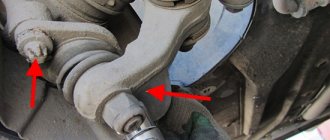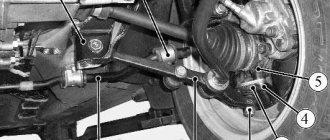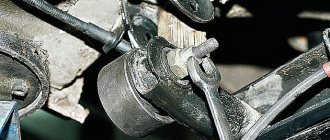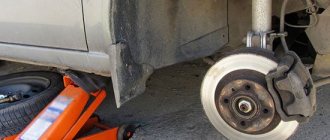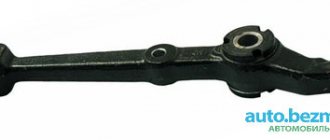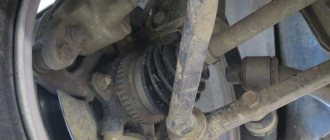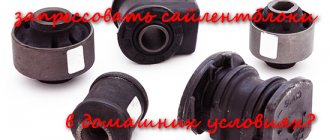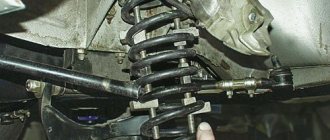After replacing the struts, supports, steering and ball bearings, the knocking noise when driving on rough roads did not disappear. And then the other day I crawled under the car and noticed the damaged silent blocks.
I went online to see how this whole thing is changing and someone on Drive found a post about replacing silent blocks and rubber bands, or popularly known as “Daisies.” After studying the material, I finally decided to change them.
We bought silent blocks, front suspension extension joints (“Daisies”), as well as stabilizer bushings and anti-roll bar struts (popularly “Eggs”).
We drive the car into the pit and fix it. Safety comes first. First, I recommend filling all the bolts and nuts with WD-40 and letting them sit.
Next, we tear off the nuts of the lever, brace and “eggs”. If you can’t unscrew the nut of the extension, you can unscrew the crab and unscrew the extension later, in more convenient conditions. Next, we raise the car, remove the wheel, unscrew the 2 ball bolts, unscrew and remove the “egg”, unscrew the extension nut, the lever bolt and remove the lever.
So, now you need to get rid of the old silent block. There are several options: 1. Burn it with a torch. 2. Drill out. 3. Use a special puller. 4. Be smart.
Since I didn’t have a drill, a torch, or a puller, I chose the 4th point. I cut off one side of the silent block with a knife and knocked it out with a hammer.
Afterwards, it is necessary to clean the seat from rust and dirt, otherwise the new silent block will not be pressed into place.
Here. Now you need to press the new silent block into place. There are also several options here: 1. Use a special puller. 2. Using a vice. 3. Be smart.
Here, too, I chose the 3rd point. Using my ingenuity, I assembled this puller.
Next we look at how to use it in the photo:
Before assembly, lubricate the lever eye and silent block with liquid soap or detergent. You cannot use grease, lithol or oil, because... The rubber is not oil resistant and will quickly become rough and crack. To press the silent block in, use a screwdriver to push the collar into the hole. It may not work out the first time, you will have to suffer.
By tightening the bolt, we press the silent block in and somewhere halfway it will rest against the puller washer. And then the puller was modified:
To put the silent block in place you need to use some kind of thread and tube. The inner ring of the wheel bearing caught my eye (see photo above). It fits just right. We press the silent block in completely, not forgetting to lubricate it with soap.
Now we change the daisies. We knock out the old ones with a chisel. For me they fell apart into 2 parts.
We clean the seat, lubricate it with lithol and hammer new ones into place.
We put the lever in place. We tighten all the bolts, tighten the ball bolts at once.
ATTENTION! IT IS STRICTLY PROHIBITED TO TIGHTEN THE BOLTS WITH THE MACHINE RAISED. OTHERWISE, WHEN LOWERING THE CAR, THE BUSHING BLOCKS MAY TEAR.
We put the wheel on, lower the car and tighten all the bolts. Along the way, we change the stabilizer bushings and install the “eggs”.
After repair, it is recommended to do a wheel alignment.
I think this post will be useful to someone. Thank you for your attention_)).
Today we will talk about how to replace silent blocks on a VAZ 2110.
The suspension is one of the most loaded devices of a car, since it constantly absorbs all the oscillatory movements of the wheel that are transmitted to it from the road surface.
Suspension design features
A feature of the suspension design is that many of its elements should not be rigidly connected, otherwise it will transfer all the vibration to the body.
How does the VAZ 2110 suspension work?
Therefore, some composite suspensions are connected by means of rubber bushings and rubber pads with metal bushings inside, i.e. silent blocks.
So, in the front independent suspension of the VAZ-2110 the following are connected to each other through silent blocks:
- Lower arm;
- Stretching;
- Anti-roll bar.
Each of these elements plays an important role in the suspension design.
The lower arm prevents lateral movement of the wheel, the extension prevents the wheel from moving longitudinally relative to the body, and the anti-roll bar prevents the body from swaying when performing maneuvers or when driving over uneven surfaces.
Read also: Do-it-yourself radio from a tablet
But the loads on these elements coming from the wheels are very large, so their displacement, although small, must be provided in order to partially absorb the loads and partially absorb them, and not transfer them to the body.
The possibility of displacement of suspension elements relative to each other and relative to the body, as well as partial damping of vibrations, is provided by silent blocks and rubber bushings.
On the VAZ-2110, silent blocks and bushings are installed in the front suspension:
- Lower arm (two silent blocks - through one it is attached to the body, and through the second a stretcher is connected to it);
- Stretch bar (one silent block through which it is attached to the crossbar);
- Anti-roll bar (it is connected to the lower arm through a strut with two silent blocks, and to the car body through brackets with rubber bushings).
Since the VAZ-2110 has a dependent rear suspension, so many silent blocks are not required, because it is structurally simpler.
At the rear of the entire suspension there are only two silent blocks installed - through which the rear beam is attached to the body brackets.
Description
Silent blocks are used to connect suspension parts and dampen vibrations transmitted from one unit to another. In the simplest case, a silent block consists of two metal bushings, between which an elastic, most often rubber, bushing is pressed or glued. As the suspension moves, it deforms and allows the suspension elements to move.
Thus, ensuring the mobility of suspension elements relative to the body and each other is the main function of silent blocks, but far from the only one. The next function is to ensure comfort - protecting the body from vibrations and noise during the operation of the suspension of VAZ cars, which is carried out due to the presence in the silent block of a layer of rubber or polyurethane, which has high elasticity and good vibration and noise insulation properties.
It is impossible not to mention the influence of silent blocks on the handling of the car. That is why, in pursuit of the best combination of comfort and controllability, automotive engineers use silent blocks with different brands of rubber, different shapes, compositions of different materials and reinforcement.
Have you ever thought that even the simplest silent block (front or rear), if faulty - for example, with a cracked rubber bushing - will be a source of knocking or squeaking? All this will affect the car’s handling - with faulty parts, the car will be prone to slipping, may “scour” along the trajectory and you will not be able to avoid constant steering. In addition, a faulty silent block causes breakdown or premature wear of associated parts, and in some cases, leads to damage to the body.
When talking about silent blocks, it is necessary to mention the ShS hinges. Their main function is to ensure the mobility of the suspension elements, but the hinge itself is absolutely rigid. If, in the race to improve handling, we follow the path of increasing the rigidity of the hinge joints, then the best result will be achieved by using a joint joint. This is why they are so popular in sports, especially in asphalt disciplines. At the same time, vibration and noise protection are sacrificed, but for sports use this is not so significant. Thus, rubber silent blocks provide maximum comfort, and the ShS provides improved handling.
To combine the advantages of these two options, the SS20 company offers silent blocks for VAZ made of polyurethane of various hardnesses of its own design and production. Yellow polyurethane silent blocks are close to rubber ones in their rigidity characteristics and comfort, but surpass them in strength and wear resistance. SS20 bushings made of red polyurethane have significantly greater rigidity, and are intended primarily for use in tuning and tuning of sportier and lowered suspensions.
Advantages of polyurethane products:
- STRENGTH . The tensile strength of polyurethane is higher than that of rubber. Polyurethane elastic elements better withstand peak loads without being destroyed. The strength of the adhesive connection between polyurethane and metal parts prevents the elastic element from detaching or peeling from the metal even under extreme loads.
- RELIABILITY . In the area of large deformations, polyurethane retains its elasticity longer than rubber. Therefore, polyurethane elastic elements remain operational over a wide range of loads.
- DURABILITY . Residual deformations of polyurethane are lower than those of rubber. Thanks to this, polyurethane elastic elements retain their functionality longer.
- High wear resistance, moisture, petrol and oil resistance ensure a long service life of polyurethane elastic elements (including silent blocks) in the most unfavorable road and climatic conditions.
In addition, the service life of polyurethane parts is 4-5 times or more higher than rubber ones.
Comparison of the main characteristics of polyurethane and rubber*
| Physical and mechanical indicator | Dimension | Polyurethane | Rubber** |
| Shore hardness, scale A | Conditional units | 69 – 70 | 65 – 75 |
| Modulus of elasticity - 100% | MPa | 29 | 12 |
| Elastic modulus - 300% | MPa | 67 | — |
| Tensile strength | kg/cm² | 312 | 115 |
| Elongation at break | % | 523 | 300 |
| Resistance to tearing apart | kg/cm² | 58 | 20 |
| Shrinkage (relative permanent compression deformation) | % | 33,5 | 35-40 |
| Change in mass when exposed to an aggressive environment SZhR-7 | % | +5,98 | +35 |
| Temperature limit of brittleness | C° | -77 | -70 |
| Frost resistance coefficient based on elastic recovery after compression, at -50°C | 0,45 | 0,2 |
Consequences of consumables malfunction
It should be noted that silent blocks and bushings are consumables.
Due to heavy loads, it is possible that the rubber part of the silent block may be pressed through, detached from the metal bushing, and the rubber itself may delaminate. As a result, they are no longer able to work properly.
This results in knocking from the suspension, the appearance of creaks, when driving, especially over uneven surfaces, the car can throw from side to side, and the more wear on the silent blocks, the stronger the tossing will be.
Also, due to worn silent blocks, the angles of the wheel position - camber and toe - change, because of which the car will no longer hold the road, it will begin to drift in any direction, the tires will quickly wear out due to incorrect angles.
So, the condition of all rubber elements of the car suspension must be constantly monitored, and if signs of malfunction appear, they must be promptly replaced.
With certain knowledge and the availability of tools, you can replace silent blocks yourself without contacting a service center.
It should be noted right away that even if damage to one or two silent blocks is detected, it is better to completely replace all rubber parts of the suspension, and not just the damaged ones.
Also, all elements are replaced immediately on the left and right sides of the car.
Garage or service station
All car owners can be divided into two categories:
- Those who carry out most of the repairs themselves in their garage, and only in emergency cases turn to a car service;
- Those who prefer not to touch anything with their own hands, but completely entrust repairs and maintenance to the masters of service stations.
Each of them is right in their own way. Therefore, we have no right to reproach those who do not want to carry out repairs themselves. After all, garage and professional repair of silent blocks, like other components, has its advantages.
STO has the following advantages:
- A high-quality, responsible car service provides a guarantee for repairs performed;
- In the event of a repeated breakdown covered by the warranty, repairs will be carried out free of charge;
- Professionals are professionals; they have extensive experience and knowledge, which allows them to competently perform their work.
But first you need to find such a car service, which, alas, is not an easy matter. Many provide a guarantee, but when you re-apply, they do everything possible to prove that the breakdown does not comply with the terms of the guarantee. A banal trick.
Repairing your garage will provide the following advantages:
- Significant financial savings, since you only have to spend money on consumables;
- The quality of the work performed by a master is always in doubt if you do not know this person personally. So self-repair may be much better than at a service station;
- You purchase the silent block, and the master only installs it. Why pay money for work that you can do yourself?!;
- Guarantee that a new one will be installed instead of the old silent block. Questionable service stations can easily install an old, more or less usable silent block instead of the one you gave them. You know what the result is.
Tools and accessories
There are not so many tools that will be required to replace all consumables, but some of them are specific.
- Set of keys, heads, knobs;
- A set of new oil seals and bushings;
- Device for pressing out and pressing in silent blocks;
- Puller for ball joint;
- Jack;
- Stops;
- Vise;
- Hammer and wooden spacers;
- Soap solution.
Device for pressing out and pressing in silent blocks.
You can buy it or make it yourself.
The simplest homemade device consists of a long bolt with a nut, pieces of pipe with different diameters and several thick washers.
The principle of operation of such a device is very simple.
To press out the silent block, take a bolt and put a washer on it, the size is slightly smaller than the diameter of the rubber part of the silent block.
The bolt is passed through the bushing of the silent block. On the other hand, a piece of pipe with a diameter equal to the diameter of the seat, for example, a lever, is thrown onto the bolt.
That is, the pipe will have to rest against the circumference of the seat in the lever.
Next, another washer is put on the bolt, its circumference larger than the diameter of the pipe, and then the nut is screwed on.
Pressing out is done like this: the nut, when screwed on, will pull towards itself the washer resting on the silent block.
The installed tube will allow it to come out of the seat and not rest against another washer.
Pressing is done in exactly the same way, with the only difference that it is not necessary to use a piece of pipe, since the silent block will rest against the thrust washer when it sits in place.
You can even press-fit without using a device; it is enough to have only a vice, between the jaws of which a new silent block and lever are installed, so that it and its seat are on the same axis.
Next, the vice compresses and the consumable itself falls into place. But in this way you can install silent blocks only on the lever and stabilizer struts, but on the cross member you will still need a device for replacement.
Disassembly
Using the example of the Opel Zafia B, a method for replacing the silent blocks of the rear beam without completely removing the beam will be described.
Loosen the nut securing the silent block to the bracket. Unscrew the nuts securing the bracket to the car body. Remove the fastening bolt and the silent itself. Don't forget to mark where the silent block was located relative to the bracket! Operations No. 1-3 should be performed on the second side as well. Raise the rear of the car with a jack and secure it on stands. The beam should lower slightly, after which you will have room to press out. Assemble the puller as shown in the photo and video. The essence of pressing out is to create the necessary force by holding the bolt on one side and tightening the nut on the other side to remove the silent block from the seat. In the video, the master drills the outer ring of the rubber damper, thereby weakening the internal tension
But note that the outer ring has a thickening that allows you to carefully drill a hole. In the case of most products, you will not be able to do this trick.
Pressing and assembly
Clean the seat in the beam thoroughly. It is best to use a metal drill brush, but a regular brush with metal fibers will also work. Before pressing, generously lubricate the seat with engine oil or other grease. Since the rubber damper is in a metal frame, technical fluids will not harm it and will not affect its service life in any way. On the pressing side, we recommend removing a small chamfer on the outer ring - this way the part will fit better into the mounting hole.
The same puller is suitable for pressing. As a mandrel for pressing, you can use the clip from under the old silent block. If you do not have suitable mandrels, then you can cut a square 3-4 mm thick as a stop. In this case, at the end of pressing, the rubber damper will rest against the thrust plate. To press the part flush, you will need to put something under the plate.
If necessary, the alignment can be corrected by carefully hitting the mandrel from the protruding side with a hammer.
When installing the bracket to lift and guide the beam, you will need to guide the beam into position manually or using a jack. It may be enough to lower the body. In any case, you need to navigate the place and the current situation. Initially, all the bolts and nuts only need to be tightened, then the bracket mounting bolts must be tightened. After which you can lower the car onto the wheels and tighten the bolt securing the silent block
The bolt should only tighten when the car is standing under its own weight on the ground - this is very important!
Replacing silent blocks with complete removal of the beam
Below in the video you can see the process of replacing silent blocks with complete removal of the rear beam. The disadvantage of this method is that you need to disconnect the brake hose, since its length is not enough to completely lower the beam. Of course, after replacement, you will need to refill the brake fluid and bleed the brakes, which is quite difficult to do alone.
Removing front suspension elements
First, we will describe the sequence of actions to restore the front suspension.
It is better to perform all work in an inspection hole, so you need to place the car on it and immediately loosen the front wheel fastenings.
The front of the car is jacked up on both sides. First, they lift one side, install supports under it, and then lift the second side with a jack and also fix it with supports, after which the wheels are removed.
Read also: Firmware for Nissan Murano z50
The first control arm to be removed from the car is the lower control arm. To do this, unscrew the nuts securing the extension, stabilizer strut and ball joint from it.
The lever is removed from the ball joint using a puller.
The last thing to unscrew is the nut securing the lever to the bracket on the body, the bolt is pulled out, and the lever is removed.
Next, the stretch is removed. Since it is already disconnected from the lever, all that remains is to unscrew the nut securing it to the cross member.
The last thing to be removed from the car is the stabilizer.
The stabilizer is attached through the struts to the levers on both sides, so you can either first dismantle it on the other side and start removing the stabilizer, or simply unscrew the nut securing its strut, and dismantle the lever itself and the brace later.
Having disconnected the stabilizer mounts to the arms, to remove it, all that remains is to unscrew the nuts securing the body brackets and remove the stabilizer along with the bushings.
Replacing consumables, eliminating axial play
Having dismantled the suspension elements, you can begin to press out the worn silent blocks and install new ones.
Using a special device prepared in advance, old silent blocks are removed from the crossbar, levers and racks and new ones are pressed into their place.
To facilitate installation, new consumables can be moistened with soapy water.
But the use of petroleum-based lubricants is not recommended, since they have a negative effect on rubber elements.
Regarding the stabilizer struts, before pressing out, they will need to be knocked off the stabilizer, since they are tightly seated on it.
When knocking down, it is better to use a hammer and strike through a wooden spacer.
Also, after removing the struts, the rubber bushings are pulled off the stabilizer and new ones are installed in their place.
Often a phenomenon called axial play occurs at the lower arm.
It is formed when the body bracket to which the lever is attached, for one reason or another, loosened and a gap appeared between it and the metal bushing of the silent block, which is why the silent block itself was able to move along the fastening bolt.
This axial play negatively affects the performance of the suspension, so it should not exist. But if it appears, then there are two ways to eliminate it.
You can try to compress the bracket. But this is very difficult to do, since it is better not to apply impact with a hammer, even through a spacer, and using clamps or a vice is not very convenient.
It is much easier to get rid of axial play using washers that are placed between the bracket and the silent block.
But according to the manual, it is recommended to replace the entire lower control arm with joints
After replacing all consumables, the removed suspension elements are installed in place.
After replacing all the silent blocks on the front suspension, the vehicle must have its wheel alignment angles adjusted.
Also check out
- You can begin installing new front suspension silent blocks. You need to treat the seat with soapy water and press it into the hole with a screwdriver (if you lubricate the hole with undiluted liquid soap, the resistance will also decrease). When everything is ready, you can start replacing the front suspension silent blocks with new ones.
- After the silent block enters 50%, remove the tube and press everything to the end. Replacing silent blocks in Steering rod silent blocks - They consist of a VAZ 2108 car. Video of replacing silent blocks on a VAZ 2109 21099 2108 steering rod: enter or. There is no need to rush so that the part is not installed crookedly. Replacing the front windows of a VAZ 2106 with glasses of a VAZ 2107. You can add soap to make the process easier.
- Check the protrusions of the silent block on all sides (should look like in the photo).
- Replace the silent block of the "daisy" lever. The old ones need to be cut down with a chisel, and new ones installed in this place. Using a vice, press them into the mounting hole. Finish with a hammer and a pointer.
- Reassemble everything in reverse order.
- The actions on the other side are similar.
- You need to tighten the nuts when the car is already on the ground.
Replacing rear suspension silent blocks
Now let's look at how to replace silent blocks on the rear suspension of a VAZ-2110.
Although there are only two of them, replacing them is not very easy, since the rear beam on which they are installed will not be removed from the car.
You won't need a lot of tools:
- A set of keys;
- New silent blocks;
- Device for pressing-pressing;
- Soap solution;
- Hammer and wooden spacer.
The car is placed on a pit and its rear is jacked up. First, replace on one side.
To begin, remove the hand brake cable from the beam. Then the nut securing the beam to the body bracket is unscrewed and the bolt is removed.
The beam is pulled down so that it is possible to reach the silent block.
To fix the beam in this position, a wooden spacer is driven between it and the body.
Next, the worn-out consumable is removed from the beam using a device, and a new element is installed in its place using the same device.
By the way, axial play may also occur in this connection, so it is important to ensure that there is no play after assembly and, if necessary, eliminate it using washers.
Next, the beam is put in place and tightened with a bolt and nut. Replacing the second silent block is done in the same way.
Using these methods, the silent blocks of the suspension of a VAZ-2110 car are replaced.
After the work is completed, the car will regain smooth running.
However, these consumables cannot serve long on our roads, so it is advisable to replace them approximately every 20 thousand km.
For garage handicraftsmen, it is a pleasure to make various devices for repairing automotive components. You can make pullers with your own hands to remove silent blocks, to remove wheel hubs, etc. All you need is desire, materials and time to make.
Read also: Niva 21213 stove tap where it is located
Also check out
- You can begin installing new front suspension silent blocks. You need to treat the seat with soapy water and press it into the hole with a screwdriver (if you lubricate the hole with undiluted liquid soap, the resistance will also decrease). When everything is ready, you can start replacing the front suspension silent blocks with new ones.
- After the silent block enters 50%, remove the tube and press everything to the end. There is no need to rush so that the part is not installed crookedly. You can add soap to make the process easier.
- Check the protrusions of the silent block on all sides (should look like in the photo).
- Replace the silent block of the "daisy" lever. The old ones need to be cut down with a chisel, and new ones installed in this place. Using a vice, press them into the mounting hole. Finish with a hammer and a pointer.
- Reassemble everything in reverse order.
- The actions on the other side are similar.
- You need to tighten the nuts when the car is already on the ground.
Worth checking out:
What is a silent block
A silent block is a rubber-metal hinge (RMH) - an element that connects two suspension parts, in this case, a car. Consists of metal and rubber. Rubber serves to dampen vibration, smooth movement, and eliminate wear caused by metal-on-metal friction.
Silent blocks or RMS - receive and dampen axial, radial, torsion and cardan vibrations. Withstands radial vibrations up to 300 kN (kilo Newton), that is, up to 300 kg.
Classification of rubber-metal silent blocks that work in torsion:
- with outer ring;
- from the inside;
- double cage;
- eccentric.
Silent blocks of this type are installed in car suspensions so that the levers and springs can move.
Classification of RMSs that work in compression with bending:
- supports;
- pillows.
Hinges of this type are installed under the engine (mounts, cushions) to dampen vibration oscillations of a running and moving engine. Protects the body from vibrations.
Silent block of the rear shock absorber VAZ 2108 dimensions
Silent blocks in VAZ , and not only in them, are hinged elements that allow mutual movements of the wheels and the car body when driving.
BUY
Share with your friends
Applicability
- VAZ 2101-2107
- VAZ 2108-2199
- VAZ 2110-2112
- VAZ 2113-2115
- VAZ 1117-1119 (Lada Kalina)
- VAZ 2170-2172 (Lada Priora)
- VAZ 2121-2131
- Chevrolet Niva
Advantages of using SS20 silent blocks in VAZ cars
- resource is 4-5 times higher than rubber ones;
- have a long service life in unfavorable road and climatic conditions;
- improve control over handling by reducing the vehicle's response time to driver actions;
- unlike rubber ones, they can withstand peak loads better without being destroyed;
- retain elasticity at temperatures down to –40˚С;
- have a progressive compression characteristic;
- do not produce chemical emissions.
Replacing silent blocks
Depending on the driving style (careful or sporty) and the quality of the roads, the lifespan of silent blocks differs. They can wear out in one summer, or they can last for several years.
Also, the service life of the RMS depends on how they were installed. In the absence of a puller, some people hit them with a hammer. If you plant silent blocks with a hammer, the rubber may be damaged and the metal bushing may move.
The average resource of silent blocks is from 100 to 150 thousand kilometers.
Selecting New Items
Polyurethane
To replace and ensure reliable operation of the car, you need to purchase good silent blocks. Choosing them is not difficult if you know some nuances:
- For the VAZ 2110 model, elements with catalog number 2110 2914054 are suitable. They have the required outer diameter corresponding to this specific VAZ model;
- Do not try to purchase a silent block from a “nine” and install it on your “ten”. Nothing will come of such events, no matter what anyone says;
- Make sure of the quality of the products. Low-grade silent blocks have flooded the market, but their service life leaves much to be desired. Good parts are made from high quality materials that can withstand extreme loads and temperatures.
What is a puller for installing silent blocks?
This is what a RMSH puller looks like, which you can make yourself. In order to make it yourself, at home, you will need the following materials and tools:
- Bolt with nut. The diameter and pitch of the thread are at your discretion. If the thread is small, you will have to turn it longer, but it will work easier and smoother.
- We select a cylinder with a diameter such that the silent block fits into it.
- Washers. Some. One washer should tightly cover the cylinder hole. You can even weld the washer on one side. We take the remaining washers with a smaller diameter than the diameter of the silent block.
A RC puller is needed not only for removal, but also for installation, so as not to damage the new silent blocks. And when removing with a puller, there is no need to hit with a hammer and there is no risk of damaging the paws (levers). If you knock out rubber-metal hinges with a hammer, microcracks may appear on the lever.
On cars with 4-link suspension, the wheel alignment angles may be disrupted if the levers or new silent blocks are damaged. In this case, you will have to change the rubber-metal bushings and, possibly, the wheels again.
In terms of cost, pullers for automobile silent blocks can be purchased at prices ranging from 800 rubles to 30,000 rubles (a set of different pullers). But, it is easy to make from improvised means. The principle of operation of a mechanical puller is that when the nut is tightened, the silent block itself is squeezed out of the eye of the lever. Hydraulic ones are more complex in design, they are more powerful, but it is better to buy them when necessary; it is impossible to make them from scrap materials.
How to make a puller
After preparing the above parts, we proceed to assembling the removable device:
- We close one end of the cylinder with one washer, with a hole for the selected bolt.
- We insert the bolt into a cylinder selected in diameter, slightly larger than the diameter of the silent block.
- After putting it on the silent block, tighten the nut.
Procedure for working with the puller:
- Remove the RMS axle. You can completely dismantle the paw and secure it in a vice, or you can press it out directly in its installed form.
- We install the puller cylinder to the silent block.
- Insert the bolt. We take the bolt of such length that you can throw on a couple of washers and tighten the nut.
- We put the washers on the bolt and begin to tighten the nut.
- Gradually the hinge will begin to slip.
If you remove silent blocks without a puller, you must use a wooden strip to avoid damaging the rods.
Video
This video shows how to make a silent block remover and how to work with it.
How to change silent blocks without a puller.
How to change silent blocks on the “classic” VAZ 2101, 2102, 2103, 2104, 2105, 2106, 2107.
How to make a puller for VAZ 2113, 2114, 2115.
How to make a puller for removing and installing rubber-metal hinges on Skoda Fabia, Skoda Rapid, VW Polo Sedan cars.
